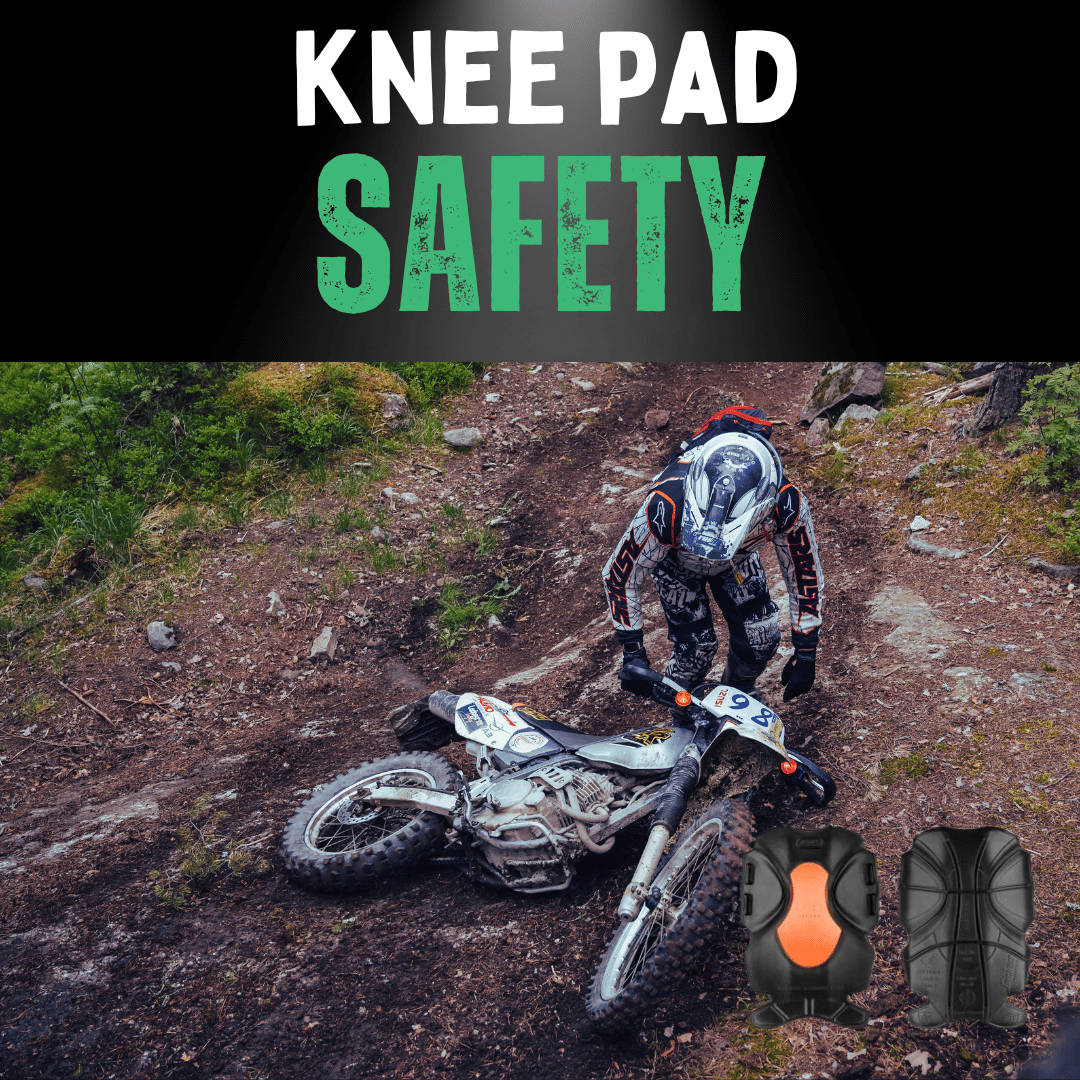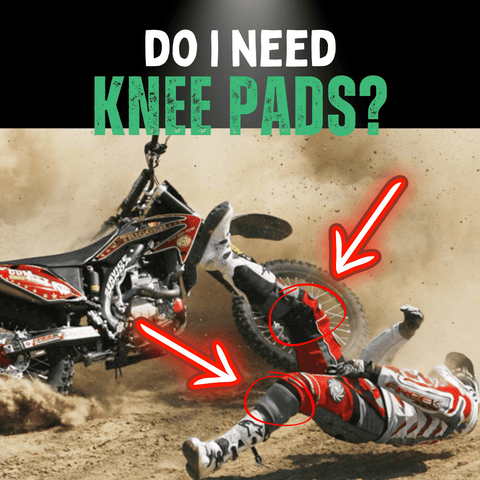
Updated: 16.05.25
Riding a dirt bike, whether for fun or professionally, is an exhilarating experience. The thrill of speeding down trails, making sharp turns, and catching air off jumps is unmatched.
However, this high-adrenaline sport comes with risks, making protective gear like knee pads essential for safety and comfort.
In this guide, we’ll walk you through choosing and wearing dirt bike knee pads to ensure a safe and enjoyable ride.
Best Dirt Bike Knee Pads: How to Wear Them for Motocross Safety
| Main Steps for Wearing Knee Pads |
|---|
| Choose the correct size for your motorcycle knee guards. |
| Wear them over a base layer, like compression shorts, for comfort. |
| Position external knee guards over your riding pants. |
| Adjust straps for a snug, secure fit. |
| Ensure coverage above and below the knee for maximum protection. |
| Test fit before riding on varied terrains. |
| Consider material and design for durability and comfort. |
| Choose weather-appropriate features (e.g., waterproof, breathable). |
| Store and maintain knee pads like other motorcycle gear. |
2. Why Knee Pads Are Essential for Dirt Biking
Safety on the Trails
Without knee pads, sliding down a rough trail or taking a tumble can lead to painful knee injuries. Knee pads absorb impact, protecting the knee joint and surrounding tissues, significantly reducing injury severity.
Comfort for Long Rides
Knee pads provide cushioning, making long rides more comfortable, especially on rough terrains or during tricky maneuvers.
Protection Beyond Falls
Besides shielding against falls, knee pads guard against cuts, scrapes, and bruises from rocks, bushes, or bike parts.
Long-Term Durability
High-quality knee pads are built to withstand rugged conditions, offering reliable protection over time.
Related: 10 Reasons You Need Knee Pads for Dirt Biking
| Type of Knee Pads | Features | Best For |
|---|---|---|
| Soft Foam Knee Pads | Lightweight, flexible, good for low-impact activities | Casual riding, beginners |
| Hard Shell Knee Pads | Rigid exterior, high-impact protection, durable | Aggressive riding, rough terrains |
| Hybrid Knee Pads | Combines soft foam and hard shell for balanced protection | All-around use, intermediate riders |
| Knee Braces | Supports stability, prevents hyperextension | Professional racing, injury prevention |
3. Finding the Perfect Knee Pads
Consult Experts
Seek advice from experienced riders or instructors at local dirt bike tracks for recommendations on the best knee pads for your needs.
Shop Smart
Choose trusted retailers or manufacturers. Prioritise quality and reputation over price for reliable dirt bike gear.
Ensure Proper Fit
Knee pads should fit snugly without restricting movement. Too tight, they’ll distract; too loose, they won’t protect effectively.
Material and Design Considerations
The material of knee pads impacts performance. Common options include:
- Foam Pads: Lightweight, comfortable, ideal for mild impacts.
- Hardshell Plastic Pads: Durable, excellent for high-impact protection.
- Gel-Based Pads: Superior shock absorption for long rides.
- Carbon Fiber Composites: Lightweight, top-tier protection for serious riders.
| Material | Benefits | Drawbacks |
|---|---|---|
| Foam Pads | Lightweight, comfortable, good for mild impacts | Less durable, limited protection for severe impacts |
| Hardshell Plastic Pads | High durability, excellent impact protection | Heavier, may restrict movement |
| Gel-Based Pads | Superior shock absorption, comfortable for long rides | More expensive, heavier |
| Carbon Fiber Composites | Lightweight, high durability, top-tier protection | Expensive, not necessary for all riders |
When choosing knee pads, consider designs with features like metal inserts or adjustable clasps for a secure fit, especially for motocross or casual riding.
4. Wearing Knee Pads Like a Pro

Follow these steps to wear knee pads properly for maximum safety and comfort during your dirt bike rides.
- Choose the Right Size: Ensure knee guards fit properly, similar to selecting motorcycle helmets, for optimal protection.
- Wear Over a Base Layer: Use compression shorts to prevent chafing and enhance comfort.
- Position Over Riding Pants: External knee guards should sit over trousers to stay secure and prevent slipping.
- Adjust Straps: Secure straps for a snug fit, noting that knee braces may offer more rigid support than pads.
- Ensure Full Coverage: Protect above and below the knee to guard against bruises, ligament injuries, or hyperextension.
- Test Fit Before Riding: Confirm pads are snug and don’t restrict movement on varied terrains.
- Consider Pants with Built-In Pads: Some motocross pants with knee pads have internal protectors, offering a streamlined fit. Ensure they cover above and below the knee for full protection.
5. Maintaining Your Knee Pads
Storage Tips
- Store Properly: Keep knee pads in a cool, dry place away from direct sunlight to prevent material degradation.
- Avoid Folding: Lay pads flat or hang them to prevent creases and extend their lifespan.
Maintenance Tips
- Inspect Fastenings: Regularly check buckles or Velcro for wear and replace if needed.
- Rotate Pairs: Use two pairs to extend lifespan and ensure a backup is ready.
- Clean Gently: Use mild soap and water, checking manufacturer guidelines for machine washing.
When to Replace
If knee pads no longer fit snugly, show significant wear, or feel ineffective, replace them to maintain protection.
6. Ride Safely with Confidence
Knee pads are a key part of safe dirt biking, but they’re not a complete shield. Combine them with cautious riding, respect for trails, and awareness of your limits for the best experience.
Related: 10 Must-Have Kids’ Motorcycle Gear for Safety
7. Choosing the Best Dirt Bike Knee Pads for You
Finding the best dirt bike knee pads depends on your riding style and needs. For aggressive motocross riders, hard shell or hybrid knee pads offer superior impact protection. Casual riders may prefer lightweight foam pads for comfort. For kids, look for adjustable, smaller-sized knee pads designed for young riders, ensuring a snug fit without restricting movement. Check out our kids’ motorcycle gear collection for options tailored to younger adventurers.
When shopping, prioritise CE Level-2 certified pads for top-tier safety. Brands like Fox Racing and Alpinestars are trusted for durability and performance. Always try pads on to ensure a proper fit, especially for kids’ dirt bike knee pads.
Frequently Asked Questions
Why are knee pads essential for dirt biking?
Knee pads designed for dirt biking offer impact protection and guard against abrasions, reducing the risk of knee injuries during spills.
Do you wear knee pads over or under pants for dirt biking?
For most dirt biking, wear external knee pads over pants to ensure they stay in place and provide maximum protection. Internal pads, built into some motocross pants, sit under the fabric. Always check the manufacturer’s guidelines for proper fit.
Can motocross knee braces replace dirt bike knee pads?
Knee braces provide greater protection and support, suitable for extreme motocross, but may be overkill for casual riding compared to standard knee pads.
How often should I replace my dirt bike knee pads?
High-quality knee pads, especially CE Level-2 certified, typically last 5–7 years. Replace them if they show significant wear or no longer fit snugly.
How can I ensure my knee pads last longer?
Store them in a cool, dry place, avoid folding, clean with mild soap, and rotate between two pairs to extend their lifespan.
Get in Touch 🚀
Loved our article on “Best Dirt Bike Knee Pads: How to Wear Them for Motocross Safety?” Ready for more dirt biking tips?
Whether you’re a parent or grandparent, we’re here to answer your kids’ ride-on toy questions! 🚗💨
Feeling curious?
Explore more at RiiRoo.com.
Or, chat with us via Live Chat to talk gear!







Share:
Does Leaving The Choke Closed Increase Fuel Consumption?
How to Be a Responsible Motorcycle Rider